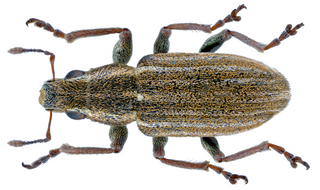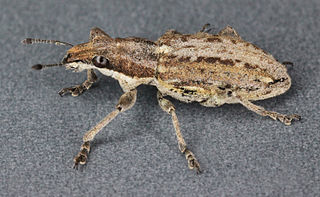
The boll weevil is a beetle which feeds on cotton buds and flowers. Thought to be native to Central Mexico, it migrated into the United States from Mexico in the late 19th century and had infested all U.S. cotton-growing areas by the 1920s, devastating the industry and the people working in the American South. During the late 20th century, it became a serious pest in South America as well. Since 1978, the Boll Weevil Eradication Program in the U.S. allowed full-scale cultivation to resume in many regions.

Weevils are certain beetles, namely the ones belonging to the superfamily Curculionoidea. They are usually small, less than 6 mm (0.24 in), and herbivorous. About 97,000 species of weevils are known. They belong to several families, with most of them in the family Curculionidae. Some other beetles, although not closely related, bear the name "weevil", such as the biscuit weevil, which belongs to the family Ptinidae.
Eype Mouth is a natural break in a line of sea cliffs on the Jurassic Coast World Heritage Site in west Dorset on the south coast of England. The small River Eype drains into the sea at this point. Eype means 'a steep place' in Old English. The village of Eype lies just upstream of the rivermouth, which is reached by a single narrow lane which runs down through Lower Eype to a shingle beach with car park.

Sitona is a large genus of weevils in the family Curculionidae native to the Nearctic and Palaearctic regions. Over 100 species have been described. Sitona is easily distinguished from related genera by flat, recumbent scales on the mandibles, by the absence of an oval scar on the mandibles, by short and broad rostrum with a deep, longitudinal, median groove, and by dense scales on the body.

The Entiminae are a large subfamily in the weevil family Curculionidae, containing most of the short-nosed weevils, including such genera as Otiorhynchus, Phyllobius, and Sitona. Some of these weevils are notorious pests of major economic importance.

Sitona lepidus or clover root weevil is a species of weevil found in Europe. It has now spread to North America and New Zealand.
S. flavescens may refer to:
Sitona californicus is a species of weevil in the family Curculionidae that can be found in Nearctic and in US states such as Arizona and California. In California the species were recorded between March 5, 1925 and February 1, 1926 at Monterey County, Carmel while in Arizona it was found in Pima county, Santa Rita Mountains.

Listronotus bonariensis is a species of weevil that is native to South America and is commonly known as the Argentine stem weevil. It is a pest of grasses and cereals, with the larvae being more destructive than the adult insects. It has spread to Australia and New Zealand, where it is regarded as a pest species.

Sitona lineatus, commonly known as the pea leaf weevil is a species of weevil with a Paleartic distribution. It is a common pest of beans, peas, and other plants in the family Fabaceae.

Sitona sulcifrons is a species of weevil native to Europe.

Sitona macularius is a species of weevil native to Europe.

Sitona hispidulus is a species of weevil native to Europe.

Sitona griseus is a species of weevil native to Europe.
Sitona californius is a species of broad-nosed weevil in the beetle family Curculionidae. It is found in North America.

Sitona cylindricollis, the sweetclover weevil, is a species of broad-nosed weevil in the beetle family Curculionidae. It is found in North America.
Sitona lineellus, the alfalfa curculio, is a species of broad-nosed weevil in the beetle family Curculionidae. It is found in North America.












